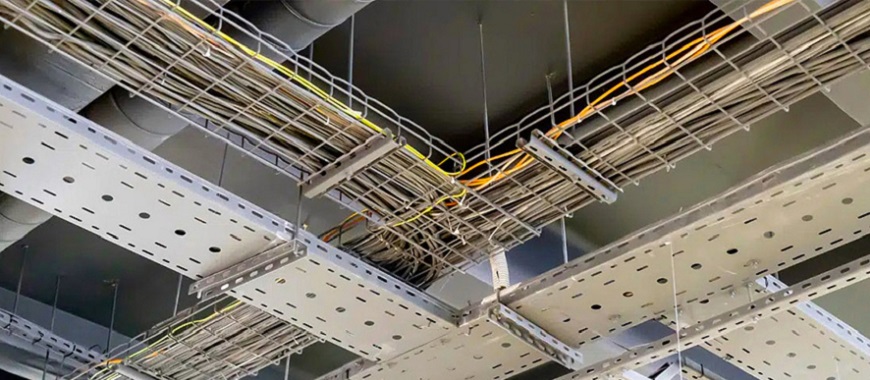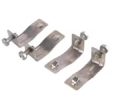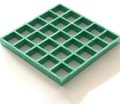
A cable tray production line plays a crucial role in modern manufacturing. It is widely used in industrial and commercial applications to create efficient cable management systems. These lines are designed to produce durable trays that support cables, ensuring safety and reliability. They contribute significantly to organizing cable networks by providing structured pathways for wires and cables.With a cable tray production line, the risks of cable damage, overheating, or crushing are minimized. The production process allows for customization, meeting the diverse needs of various industries. Additionally, cable trays produced in these lines simplify maintenance by making cable additions and removals easier. This efficiency helps maintain orderly operations in facilities of all sizes.
What Is a Cable Tray Production Line?
A cable tray production line is a manufacturing system designed to produce cable trays used in cable management systems. These trays provide a structured and safe pathway for electrical and communication cables in industrial and commercial environments. The production line is equipped to create various profiles and sizes of cable trays, ensuring versatility for different applications.
Cable tray production lines are integral to modern cable management. They allow for efficient organization and protection of cables, which is critical in reducing risks like overheating, crushing, or mechanical stress. By ensuring uniform production, these lines help maintain consistent quality standards and adapt to specific requirements.
Core Purpose of a Cable Tray Production Line
The primary goal of a cable tray production line is to create high-quality cable trays that meet safety and performance standards. These trays:
- Support and protect cables, ensuring uninterrupted operations in electrical systems.
- Simplify the process of cable installation, maintenance, and replacement.
- Provide customizable options for industries requiring specific sizes, profiles, and materials.
Importance in Modern Cable Management Systems
Cable tray production lines contribute significantly to improving cable management by:
- Enhancing safety: Properly manufactured trays reduce the risks of overheating, crushing, or exposure to environmental elements.
- Streamlining operations: Trays produced offer efficient pathways, making cable additions and removals straightforward.
- Reducing downtime: Organized cables ensure quicker identification of issues during maintenance or upgrades.
Components of a Cable Tray Production Line
A cable tray production line consists of several integrated components, each playing a crucial role in the manufacturing process. These components ensure precision, efficiency, and adaptability for various production needs.
- Coil Feeding Systems (Sheet or Coil Options)
Cable tray production line material, typically galvanized steel or stainless steel, is fed into the line through coil feeding systems. These systems can handle sheet or coil materials, accommodating different production requirements. High-capacity feeding systems ensure uninterrupted operation, reducing delays in manufacturing. - Servo-Controlled Feeding Mechanisms for Precision
Servo-controlled systems ensure the accurate feeding of materials into the punching or cutting units. Precision in this stage is essential to maintain consistency in tray dimensions and reduce material wastage. - Punching and Cutting Units for Streamlined Assembly
These units handle the creation of slots, holes, and other designs required in cable trays. Integrated punching and cutting systems enhance production speed while maintaining the structural integrity of the trays.
Benefits of Using a Cable Tray Production Line
A cable tray production line offers several advantages, making it an essential investment for industries requiring efficient cable management solutions.
- Safe Transportation and Protection of Cables
Trays manufactured ensure cables are protected from mechanical damage, overheating, and environmental factors. This minimizes risks like electrical faults or fires. - Simplified Addition and Removal of Cables
Well-designed trays facilitate easy cable access, making it simpler to add, remove, or replace cables without disrupting the overall system. - Customizable Options for Widths, Thicknesses, and Profiles
The production line allows for customization of cable tray production line material, dimensions, and profiles. This flexibility caters to diverse industries with unique requirements.
Cable Tray Production Line:Key Features and Specifications
The cable tray production line is engineered with advanced features to meet industry demands. These features enhance efficiency, precision, and adaptability.
Standard Specifications
Standard specifications define the baseline capabilities of a cable tray production line, ensuring it meets general manufacturing needs.
- Material Types: Galvanized Steel and Thickness Range
The cable tray production line material commonly used includes galvanized steel, with thickness ranges from 0.40mm to 0.60mm. This range offers the balance between durability and flexibility. - Production Speeds
Standard lines operate at speeds of up to 60 meters per minute. This ensures high-volume production without compromising quality. - Typical Line Configurations and Size Capacities
Cable trays are produced in a variety of configurations, including straight sections, bends, and T-sections. The production line can handle widths up to 300mm, accommodating most industry standards.
Optional Features
Optional features allow manufacturers to enhance the capabilities of their cable tray production lines, ensuring adaptability to more complex demands.
- Enhanced Production Speeds and Thickness Options
Advanced lines can operate at speeds up to 100 meters per minute. Additionally, they support material thicknesses of up to 1.5mm for heavy-duty trays. - Rotary Punching and Motorized Marking Units
These technologies allow for intricate patterns and designs on cable trays. Rotary punching enhances speed, while marking units improve tray identification. - Quick-Change Rollforming Mills for Non-Standard Profiles
Quick-change systems enable faster transitions between different tray profiles, reducing downtime and improving production efficiency.
This structure provides a comprehensive guide to understanding cable tray production lines, their components, and their importance in modern manufacturing systems.
Cable Tray Orange Options for Industrial Settings
Types of Cable Tray Production Lines
Cable tray production lines are designed to cater to various industrial needs, ranging from standard to heavy-duty applications. Each type accommodates specific requirements based on the cable tray production line material, thickness, and design preferences. These lines also support customization for non-standard sizes, ensuring flexibility for unique projects.
Medium-Duty Production Lines
Medium-duty production lines are ideal for manufacturing trays with lighter materials, often used in standard applications. These lines focus on efficiency and cost-effectiveness, making them suitable for industries with moderate load requirements.
- Key Features of Medium-Duty Production Lines:
- Material Compatibility: Medium-duty lines typically process cable tray production line material like galvanized steel or aluminum, with thicknesses ranging from 0.40mm to 0.60mm. These materials provide sufficient strength for lightweight applications while remaining cost-efficient.
- Production Speed: These lines can achieve speeds of up to 60 meters per minute, ensuring rapid output without compromising quality.
- Design Flexibility: Medium-duty lines support standard profiles and can incorporate simple customizations, such as minor width or depth adjustments.
- Operational Simplicity: Medium-duty lines are easy to operate, with user-friendly control panels that simplify settings and adjustments.
- Cost-Effectiveness: The design of medium-duty lines emphasizes minimal resource consumption, ensuring affordable manufacturing without reducing quality.
These lines are ideal for industries such as office buildings, residential projects, and small-scale industrial setups. Their ability to handle standard applications efficiently makes them a popular choice for businesses seeking reliability without excessive costs.
Heavy-Duty Production Lines
Heavy-duty production lines are engineered for manufacturing cable trays designed to handle high loads and harsh environments. They often utilize thicker steel materials to ensure enhanced durability and long-term performance.
- Key Features of Heavy-Duty Production Lines:
- Material Thickness: Heavy-duty lines process cable tray production line material up to 1.5mm thick, ensuring durability for demanding applications.
- Enhanced Durability: Products from these lines resist mechanical stress, corrosion, and high temperatures, making them suitable for industrial and outdoor environments.
- Advanced Technologies: Heavy-duty lines incorporate rotary punching and servo-controlled feeding systems for precise and efficient production.
- Customization: These lines can produce non-standard tray sizes, offering flexibility for unique industry requirements.
- High-Load Applications: Heavy-duty cable trays are ideal for industries such as manufacturing plants, oil refineries, and data centers where cable networks are extensive and heavy.
Heavy-duty production lines provide robust solutions for complex and high-demand cable management systems. Their ability to produce durable trays ensures long-term reliability, even in challenging conditions.
Innovations in Cable Tray Production Technology
Advancements in cable tray production line technology focus on improving efficiency, reducing operational costs, and enhancing precision. Modern lines integrate cutting-edge systems to meet the evolving needs of industries.
Energy-Saving Technologies
Energy-saving technologies in cable tray production lines allow manufacturers to achieve the same output with reduced power consumption. This not only lowers costs but also contributes to environmental sustainability.
- Advantages of Energy-Saving Features:
- Reduced Operational Costs: Energy-efficient motors and systems minimize electricity usage, significantly reducing production expenses.
- Environmental Benefits: Lower energy consumption aligns with sustainability goals, helping businesses meet environmental standards.
- Consistent Performance: Despite reduced energy usage, these technologies ensure steady production speeds and high-quality outputs.
- Long-Term Savings: By reducing energy demands, these systems decrease wear and tear on equipment, extending their lifespan.
- Custom Configurations: Manufacturers can adapt energy-saving features to suit the cable tray production line material and specific production needs.
Energy-saving innovations are essential for businesses looking to optimize production while maintaining an eco-friendly approach. Their impact extends beyond cost savings, contributing to a greener industrial environment.
Servo-Controlled Systems
Servo-controlled systems are a game-changer in cable tray production line technology, offering unparalleled accuracy and efficiency. These systems automate feeding, punching, and cutting processes with precision.
- Benefits of Servo-Controlled Systems:
- Error Reduction: Precise control minimizes material wastage and ensures consistent product dimensions.
- Enhanced Speed: Servo systems allow for faster production rates without compromising accuracy or quality.
- Adaptability: Operators can adjust settings quickly to accommodate different cable tray production line materials and designs.
- Ease of Use: Intuitive interfaces simplify operations, reducing the learning curve for operators.
- Improved Product Quality: Consistent feeding and punching result in trays that meet exact specifications every time.
Servo-controlled systems are essential for manufacturers aiming to produce high-quality trays efficiently. Their role in reducing errors and improving speed makes them a valuable addition to any production line.
Integration of Punching and Cutting Units
Integrated punching and cutting units streamline the production process, ensuring seamless transitions between stages. This integration reduces downtime and increases overall productivity.
- Advantages of Integrated Systems:
- Efficiency: Combined punching and cutting eliminate the need for manual interventions between processes, speeding up production.
- Precision: Integrated units ensure perfect alignment, resulting in accurately punched and cut cable tray production line materials.
- Versatility: These units can handle a wide range of tray profiles, accommodating both standard and custom designs.
- Reduced Maintenance: Fewer separate systems mean less maintenance, lowering operational disruptions.
- High-Volume Production: Integrated systems are ideal for industries requiring large-scale manufacturing of cable trays.
By simplifying the production process, integrated punching and cutting units enhance both speed and precision. Their role in high-volume production makes them indispensable for modern cable tray manufacturing.
Efficient Cable Tray Sealing System for Industrial Applications
Applications of Cable Tray Production Lines
Cable tray production lines serve a wide range of applications across various settings, addressing the needs of industrial, commercial, and residential projects. Each setting leverages the capabilities of cable tray production lines to ensure efficient cable management and reliable system operation.
Industrial Applications
In industrial environments, cable tray production lines are used to create heavy-duty trays that can support extensive cable networks. These trays are essential in:
- Manufacturing Plants: Ensuring organized pathways for power and communication cables in large-scale operations.
- Oil and Gas Refineries: Protecting cables from harsh conditions such as high temperatures and corrosive environments.
- Data Centers: Supporting high-density cable systems for seamless connectivity and performance.
- Energy Plants: Managing complex electrical systems in renewable and non-renewable energy facilities.
Commercial Applications
Commercial buildings require cable tray production lines for producing trays that simplify cable installation and maintenance:
- Office Buildings: Organizing cables for telecommunication and IT systems.
- Hospitals: Ensuring safe and efficient pathways for medical equipment cables.
- Shopping Centers: Supporting lighting and security systems with flexible tray designs.
Residential Applications
In residential projects, lighter trays manufactured through cable tray production lines are widely used:
- Apartment Complexes: Facilitating structured cabling for electricity, internet, and security systems.
- Smart Homes: Supporting advanced automation systems with customizable cable management solutions.
Factors to Consider When Choosing a Cable Tray Production Line
Choosing the right cable tray production line depends on several critical factors. Evaluating these aspects ensures the line aligns with specific project requirements and maximizes efficiency.
Material and Thickness Requirements
The cable tray production line material must match the project’s durability and load-bearing needs. Considerations include:
- Material Types: Galvanized steel for corrosion resistance or aluminum for lightweight applications.
- Thickness: Projects requiring heavy-duty trays often need material thicknesses up to 1.5mm.
Speed and Capacity Needs
Production speed impacts how quickly trays can be manufactured to meet demand. Key factors include:
- Standard Speeds: Up to 60 meters per minute for medium-duty trays.
- High-Speed Lines: Options reaching 100 meters per minute for large-scale projects.
Flexibility for Custom Designs and Profiles
Flexibility ensures the production line can adapt to diverse project requirements. Important features include:
- Custom Profiles: Lines capable of producing non-standard shapes for unique applications.
- Quick-Change Mills: Enabling rapid transitions between designs without significant downtime.
Substation Cable Tray Benefits for Power Infrastructure
Technical Specifications of a Cable Tray Production Line
The technical specifications of a cable tray production line determine its capabilities and performance. Each component contributes to efficient manufacturing.
Feeding Systems
Feeding systems are essential for introducing cable tray production line material into the manufacturing process:
- Servomotor-Based Feeding: Ensures precision in material alignment and minimizes waste.
- Non-Motorized Options: Suitable for budget-conscious operations requiring basic functionality.
- Motorized Feeders: Offer enhanced efficiency and support higher production speeds.
Roll Forming Machines
Roll forming machines shape the cable tray production line material into finished products:
- Standard Configurations: Ideal for medium-duty trays with 10-12 stations.
- Advanced Configurations: Feature up to 18 stations for complex profiles and thicker materials.
- Rollers and Shafts: Made from steel alloys, ensuring durability and consistent performance.
Real-Life Applications and Case Studies
Real-world examples illustrate the practical benefits of cable tray production lines. These cases highlight successful installations and adaptations for specific industries.
- Manufacturing Plant in Germany: A cable tray production line was used to install heavy-duty trays, improving organization and reducing downtime.
- Data Center in Singapore: Custom trays supported high-density cable systems, enabling better airflow and optimized performance.
- Oil Refinery in the Middle East: Durable trays were produced to withstand harsh temperatures and corrosive conditions.
- Hospital in Canada: Medium-duty trays were installed to ensure safe management of power and communication cables.
- Smart Home Project in Japan: Customizable trays supported advanced automation systems, simplifying maintenance and upgrades.
Summary of Cable Tray Production Lines
Cable tray production lines are vital for modern cable management. They ensure efficiency, safety, and adaptability across diverse applications. By considering factors like material requirements, speed, and design flexibility, businesses can invest in solutions that align with their needs. Advanced features, including servomotor systems and roll forming technologies, further enhance performance. For industries looking to optimize their cable management systems, choosing the right cable tray production line is a crucial step toward improved efficiency and reliability.

As the editor of GangLong Fiberglass, I have years of experience and in-depth research, focusing on cable tray products, fiberglass solutions, and grille systems. I incorporate years of industry insights and practical experience into every content, committed to promoting the progress of the industry. At GangLong Fiberglass, my commitment is reflected in every product, from innovative cable trays to durable fiberglass solutions and sturdy grille systems. As an authoritative voice in the industry, my goal is to provide valuable information to professionals and businesses and promote forward-looking solutions.


